#transcription and translation for educators
Explore tagged Tumblr posts
Text
Translation Services and Subtitling Services for Online Tutorials
Online learning has seen a significant rise, especially post-pandemic. Accessible and effective communication is crucial in online education. Key tools like transcription, translation, subtitling, live captioning, and note-taking enhance the learning experience. The Rise of Online Learning The shift to online learning accelerated during the pandemic. Many institutions and learners had to adapt…

View On WordPress
#academic note-taking solutions#academic transcription solutions#accessibility tools for online education#accessible learning materials#digital note-taking for education#e-learning captioning services#e-learning subtitling services#e-learning transcription services#e-learning translation solutions#educational accessibility services#educational live captioning services#educational subtitling services#educational support services#educational transcription services#educational translation services#effective note-taking strategies for students#inclusive education technology#live captioning for online courses#live lecture captioning#multilingual education support#multilingual subtitling for education#Note Taking Services for Students#online course transcription services#online learning accessibility tools#real-time captioning for education#real-time translation for education#subtitling and captioning for online courses#subtitling services for online tutorials#transcription and note-taking for students.#transcription and translation for educators
0 notes
Text
Reach Your Audience in Any Language With Certified Translation Dallas
Certified Translation Dallas is your go-to provider for professional translation services in Dallas. Our team of experienced translators is adept in multiple languages, including Spanish, French, Arabic, and many more. We specialise in translating essential documents and professional communications, ensuring your message is clearly understood by your target audience.
Our three-step process ensures efficiency and accuracy. From the initial submission of your documents to the final delivery of the translated text, we maintain a streamlined workflow that allows us to complete translations in as little as 24 hours. This rapid turnaround time is essential for clients with urgent needs, enabling them to meet tight deadlines without sacrificing quality.

In addition to our translation services, we offer top-notch transcription services in Dallas, TX. Our professional transcriptionists convert audio and video files into accurate written text, capturing every detail with precision. Furthermore, our live simultaneous interpreters in Dallas, TX, provide real-time interpretation services for conferences, meetings, and other events, ensuring smooth communication between multilingual participants.
Certified Translation Dallas is committed to helping you communicate effectively and confidently across language barriers. Our comprehensive range of services is designed to meet your specific needs, ensuring that your message is accurately conveyed to your audience. Trust us to provide the professional translation services you need to succeed.
#Certified Translation Dallas#Professional Translation Services Dallas#Transcription Services Dallas TX#Interpreters Dallas TX#immigration document translation#translation of educational documents#live simultaneous interpreters
1 note
·
View note
Text
Fine dining
S's rather fruitful past collaborations with Chefs Tom Kitchin and Tony Singh are already well known by this fandom. As is C's lackadaisical Grilled! by The Staff Canteen podcast (April 2023), mentioning gin and food, as far as I remember.
By the way - we are one day shy of the first anniversary of this Instagram post:
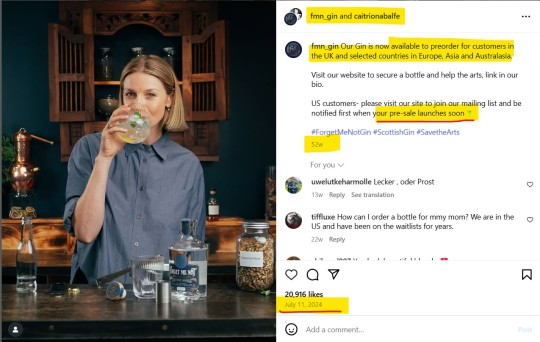
[Source: C and FMN Gin's IG accounts - posted on July 11, 2024]
We were invited - oh, well ... 'we' meaning the happy few of the selected and worthy European, Asian and Australasian countries - to preorder our bottles and 'secure' our nectar. Whatever happened? Genuinely curious, here: has anyone managed to order? was it delivered? and what about the US clientele, that was under the spell of an imminent announcement ' pre-launches soon' - could that be that it never happened, after all? Oh.
So yes, all of this is well known.
But perhaps not this tidbit:
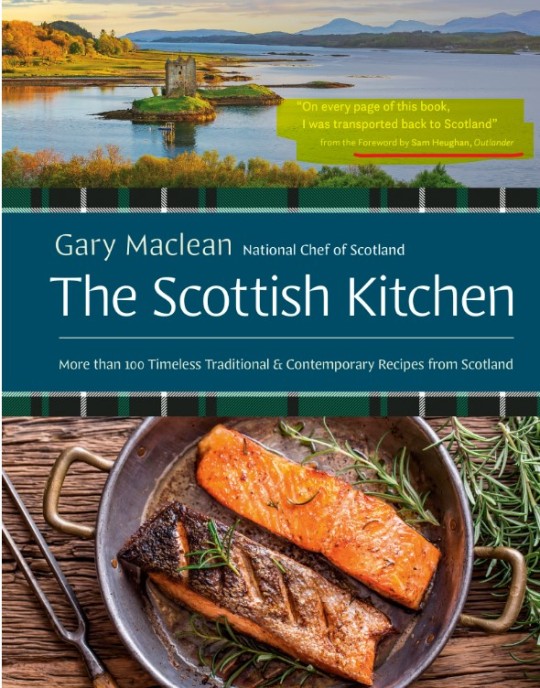
This is Gary Maclean's The Scottish Kitchen cookbook, with a foreword by S. It has been published in 2022, by Black and White Publishing (based in EDI) and Penguin Random House (in North America) and I don't remember it ever being discussed or even mentioned anywhere. If I am wrong, let it be my sin and kindly excuse me - but for the life of me, if I am right, I cannot understand why.
After all, Maclean has been officially appointed the first ever National Chef of Scotland, in 2017, by the Scottish Government, in a very official attempt to further promote healthy and gourmet local cuisine:


[Source: https://www.bbc.com/news/uk-scotland-glasgow-west-42170886 - posted on November 30, 2017]
Here is the Foreword S (or perhaps one of the Clanlands series ghostwriters) wrote for this cookbook. From my own ebook (did I tell you I have an obvious soft spot for this kind of literature?):
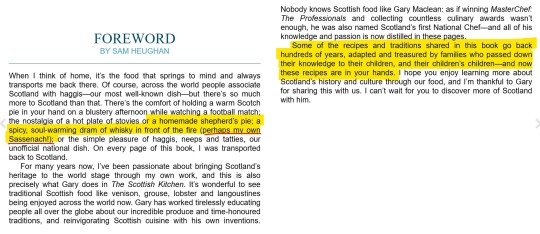
For our Spanish Mafia girls, here is a transcript that would make for an easier instant translation:
'When I think of home, it’s the food that springs to mind and always transports me back there. Of course, across the world people associate Scotland with haggis—our most well-known dish—but there’s so much more to Scotland than that. There’s the comfort of holding a warm Scotch pie in your hand on a blustery afternoon while watching a football match; the nostalgia of a hot plate of stovies or a homemade shepherd’s pie; a spicy, soul-warming dram of whisky in front of the fire (perhaps my own Sassenach!); or the simple pleasure of haggis, neeps and tatties, our unofficial national dish. On every page of this book, I was transported back to Scotland.
For many years now, I’ve been passionate about bringing Scotland’s heritage to the world stage through my own work, and this is also precisely what Gary does in The Scottish Kitchen. It’s wonderful to see traditional Scottish food like venison, grouse, lobster and langoustines being enjoyed across the world now. Gary has worked tirelessly educating people all over the globe about our incredible produce and time-honoured traditions, and reinvigorating Scottish cuisine with his own inventions. Nobody knows Scottish food like Gary Maclean: as if winning MasterChef: The Professionals and collecting countless culinary awards wasn’t enough, he was also named Scotland’s first National Chef—and all of his knowledge and passion is now distilled in these pages.
Some of the recipes and traditions shared in this book go back hundreds of years, adapted and treasured by families who passed down their knowledge to their children, and their children’s children—and now these recipes are in your hands. I hope you enjoy learning more about Scotland’s history and culture through our food, and I’m thankful to Gary for sharing this with us. I can’t wait for you to discover more of Scotland with him.'
Of course, you can read into this short tidbit what the hell ever you want. Some will interpret the Sassenach mention as 'shilling' (the same crowd that does not want to understand that the Royal Shakespeare Company is not exactly some sort of Barnardo's for failed, untalented one trick ponies). Some might perhaps connect the insertion to the broader context the phrase evokes, which is a quiet family moment. More so, when we read this very surprising : 'Some of the recipes and traditions shared in this book go back hundreds of years, adapted and treasured by families who passed down their knowledge to their children, and their children’s children—and now these recipes are in your hands.'
Now why would a confirmed bachelor and apparently happy to remain so (and do #silly pap walks with foreign harlots, in the process), feel moved enough to mention such things as family, or children, in an otherwise perfectly forgettable text for what is probably a friend's book?
They do not follow him on Instagram. But Gary Maclean follows both of them:

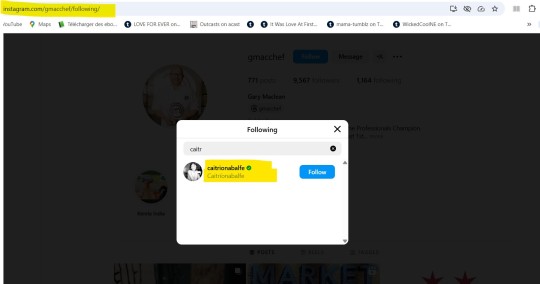
[Source: Gary Maclean's IG account]
As he does also follow, for example, Graham McTavish - why am I not surprised? That being said, this fine Glaswegian chef has never been otherwise connected to anything OL-related.
There are many things we do not know. And perhaps for the better.
Things that make you go hmmm...
95 notes
·
View notes
Text
Translated Kinako Ball
Courtesy to my sibling @yalbaystaken, who translated the soccer ball Kinako was holding in the Chrono Stone finale. The messages are adorable.
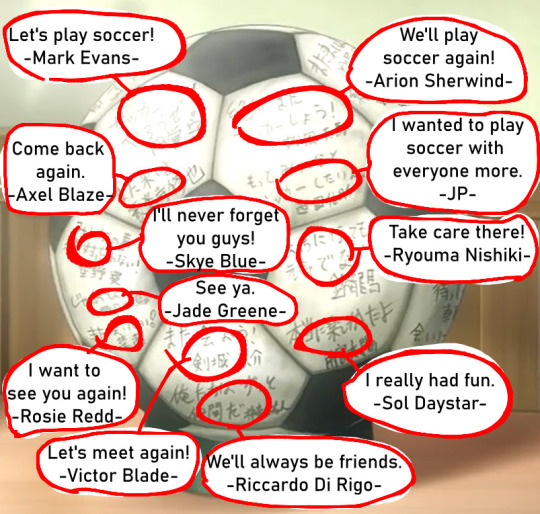
Transcription:
Let's play soccer! - Mark Evans (Endou Mamoru).
Come back again. - Axel Blaze (Gouenji Shuuya).
We'll play soccer again! - Arion Sherwind (Matsukaze Tenma).
I wanted to play more soccer with everyone. - J.P. Lapin (Nishizono Shinsuke).
Take care! - Ryouma Nishiki (Nishiki Ryouma).
I'll never forget you guys! - Skye Blye (Sorano Aoi).
See ya. - Jade Greene (Seto Midori).
I want to see you again! - Rosie Redd (Yamana Akane).
Let's meet again! - Victor Blade (Tsurugi Kyousuke) (yes, with the exclamation mark. he's adorable)
We'll always be friends. - Riccardo Di Rigo (Shindou Takuto).
I really had fun. - Sol Daystar (Amemiya Taiyou).
EDIT: On the rightmost lowest hexagon, it can be guessed that it says:

We'll always we waiting for you - Subaru Honda (Kurumada Goichi). (Only "itsudemo matte" / "always wait" can be seen, alongside with "Kurumad". The rest is an educated guess.)
I'd like to meet you again - Wanli Changcheng (Amagi Daichi). (Only "meet"/"ai" and "want"/"hoshii" can be seen. Half of a kanji is there too, and given its shape and that it's on the same hexagon as Kurumada, we can deduce it's Wanli's name.)
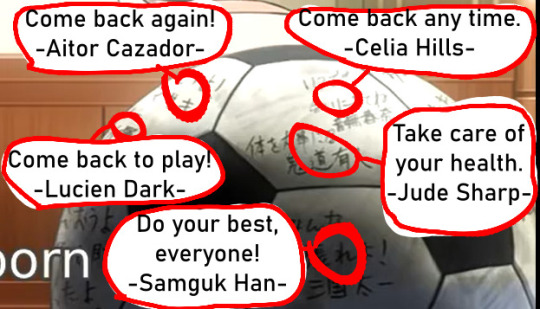
Transcription:
Come back again! - Aitor Cazador (Kariya Masaki).
Come back to play! - Lucien Dark (Kageyama Hikaru) (approximated translation, as not everything was visible).
Do your best, everyone! - Samguk Han (Sangoku Taichi).
Come back any time. - Celia Hills (Otonashi Haruna).
Take care of your health. - Jude Sharp (Kidou Yuuto).
EDIT: On the second image, on the leftmost lowest hexagon, these messages can be inferred:
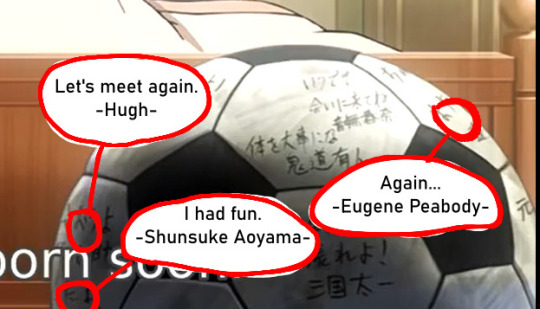
Let's meet again. - Hugh (Nanasuke Ichino). Between both perspectives, "Mata", "ao yo" (the full message) and "Nanasuke" can be seen.
I had fun. - Shun (Aoyama Shunsuke). "Tanoshi" "ta yo" and the kanji for "Ao" can be seen. The rest is a guess.
Meanwhile, on the other side, there are two cut hexagons:
On the top one, you can make out "mata" and the kanji for "Haya" below - Hayami/Eugene's name. The message is probably something along the lines of "mata ne"/"see you" or some such.
Over it, there's the kana for "chi", and nothing else. If we take into account the other image (upper left), we can see the last kanji for Hamano/Adé's name, so it's his message. There are two lines of kanas above his signature, but we can't make them out well - the second one is "to". Any ideas?
On the lowest rightmost hexagon, there's the kanji for "gen", presumably part of "genki (de)" (translation: "Stay well". It's used when you don't expect to see the person for a long while). There's no kanji to see who it belongs to. The people without a confirmed message are Kurama/Michael and Kirino/Gabi, so pick your poison.
(Fun fact: in the localization, at least the Spanish one, they erased the messages outright. My childhood was a lie.)

#inazuma eleven#my meta#(well not mine but they let me publish this to contribute to the fandom)#inazuma eleven go chrono stone
146 notes
·
View notes
Text
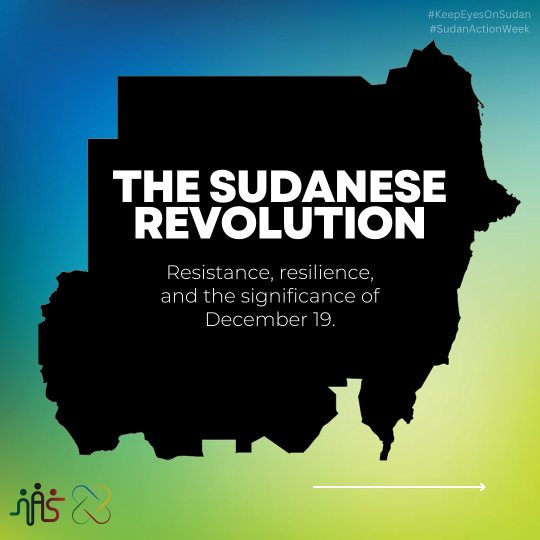
Via NasAlSudan
Learn about the Sudanese revolution, the significance of December 19, and a legacy of resistance and resilience.
Join our call to action today and everyday during Sudan Action Week.
December 19 2023
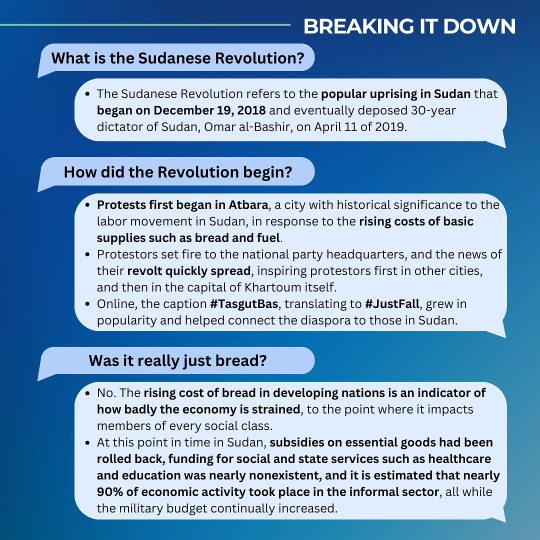
Transcript:
Breaking it down
What is the Sudanese Revolution?
The Sudanese Revolution refers to the popular uprising in Sudan that began on December 19, 2018 and eventually deposed 30-year dictator of Sudan, Omar al-Bashir, on April 11 of 2019.
How did the Revolution begin?
Protests first began in Atbara, a city with historical significance to the labor movement in Sudan, in response to the rising costs of basic supplies such as bread and fuel.
Protestors set fire to the national party headquarters, and the news of their revolt quickly spread, inspiring protestors first in other cities, and then in the capital of Khartoum itself.
Online, the caption #TasgutBas, translating to #JustFall, grew in popularity and helped connect the diaspora to those in Sudan.
Was it really just bread?
No. The rising cost of bread in developing nations is an indicator of how badly the economy is strained, to the point where it impacts members of every social class.
At this point in time in Sudan, subsidies on essential goods had been rolled back, funding for social and state services such as healthcare and education was nearly nonexistent, and it is estimated that nearly 90% of economic activity took place in the informal sector, all while the military budget continually increased.
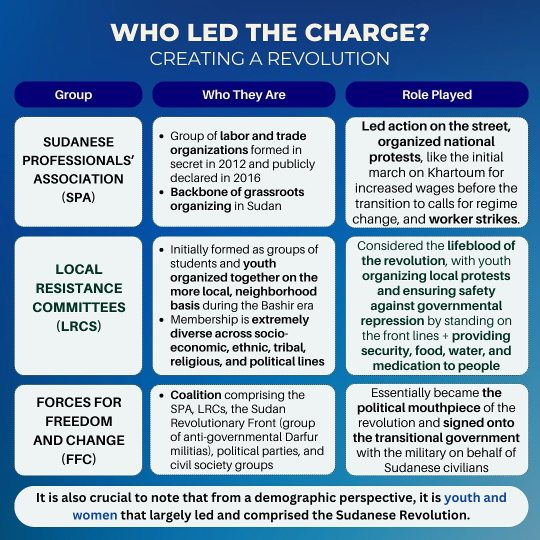
Transcript:
Who led the charge? Creating a revolution
Group: Sudanese Professional's association (SPA)
Who they are:
Group of labor and trade organizations formed in secret in 2012 and publicly declared in 2016
Backbone of grassroots organizing in Sudan
Role played:
Led action on the street, organized national protests, like the initial march on Khartoum for increased wages before the transition to calls for regime change, and worker strikes.
Group: Local Resistance Committees (LRCS)
Who they are:
Initially formed as groups of students and youth organized together on the more local, neighbourhood basis during the Bashir era
Membership is extremely diverse across socio-economic, ethnic, tribal, religious, and political lines
Role played:
Considered the lifeblood of the revolution, with youth organizing local protests and ensuring safety against governmental repression by standing on the front lines + providing security, food, water, and medication to people
Group: Forces for freedom and change (FFC)
Who they are:
Coalition comprising the SPA, LRCS, the Sudan Revolutionary Front (group of anti-governmental Darfur militias), political parties, and civil society groups
Role played:
Essentially became the political mouthpiece of the revolution and signed onto the transitional government with the military on behalf of Sudanese civilians
It is also crucial to note that from a demographic perspective, it is youth and women that largely led and comprised the Sudanese Revolution.
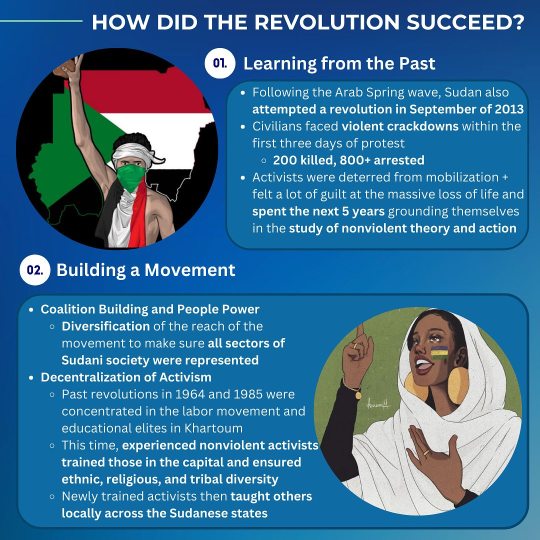
Trabscript:
How did the revolution succeed?
01. Learning from the Past
Following the Arab Spring wave, Sudan also attempted a revolution in September of 2013
Civilians faced violent crackdowns within the first three days of protest. 200 killed, 800+ arrested
Activists were deterred from mobilization + felt a lot of guilt at the massive loss of life and spent the next 5 years grounding themselves in the study of nonviolent theory and action
02. Building a Movement
Coalition Building and People Power
Diversification of the reach of the movement to make sure all sectors of Sudani society were represented
Decentralization of Activism
Past revolutions in 1964 and 1985 were concentrated in the labor movement and educational elites in Khartoum
This time, experienced nonviolent activists trained those in the capital and ensured ethnic, religious, and tribal diversity
Newly trained activists then taught others locally across the Sudanese states
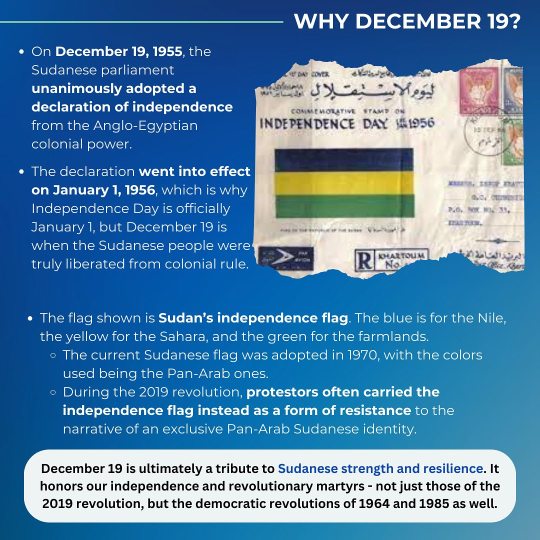
Transcript:
Why december 19?
On December 19, 1955, the Sudanese parliament unanimously adopted a declaration of independence from the Anglo-Egyptian colonial power.
The declaration went into effect on January 1, 1956, which is why Independence Day is officially January 1, but December 19 is when the Sudanese people were truly liberated from colonial rule.
The flag shown is Sudan's independence flag. The blue is for the Nile, the yellow for the Sahara, and the green for the farmlands.
The current Sudanese flag was adopted in 1970, with the colors used being the Pan-Arab ones.
During the 2019 revolution, protestors often carried the independence flag instead as a form of resistance to the narrative of an exclusive Pan-Arab Sudanese identity.
December 19 is ultimately a tribute to Sudanese strength and resilience. It honors our independence and revolutionary martyrs - not just those of the 2019 revolution, but the democratic revolutions of 1964 and 1985 as well.
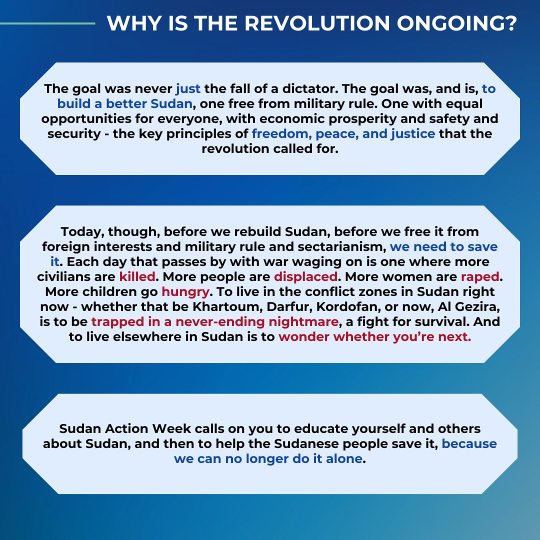
Transcript:
Why is the revolution ongoing?
The goal was never just the fall of a dictator. The goal was, and is, to build a better Sudan, one free from military rule. One with equal opportunities for everyone, with economic prosperity and safety and security - the key principles of freedom, peace, and justice that the revolution called for.
Today, though, before we rebuild Sudan, before we free it from foreign interests and military rule and sectarianism, we need to save it. Each day that passes by with war waging on is one where more civilians are killed. More people are displaced. More women are raped. More children go hungry. To live in the conflict zones in Sudan right now - whether that be Khartoum, Darfur, Kordofan, or now, Al Gezira, is to be trapped in a never-ending nightmare, a fight for survival. And to live elsewhere in Sudan is to wonder whether you're next.
Sudan Action Week calls on you to educate yourself and others about Sudan, and then to help the Sudanese people save it, because we can no longer do it alone.

Transcript:
What can you do? Uniting for Al Gezira and North Darfur
As we witness the unfolding events in Al Gezira and North Darfur, the communities of Abu Haraz, Hantoub, Medani, El Fasher, and many others are reaching out for assistance. Sudanese resilience persists to this day, with individuals on platforms like Facebook, Twitter, Instagram, and TikTok seeking and providing guidance on transportation services, medical care, food, shelter, protection, safe zones, operational markets, and more. This isn't new for the Sudanese community. A legacy of unity emerged, notably during the 2019 revolutions, where nas al Sudan [the people of Sudan], both within the nation and in the diaspora, rallied together to support each other online. Beyond merely sharing stories on social media, this was about strengthening collective action, enhancing mobilizations, and building a resilient community rooted in solidarity. The essence of the Sudanese community lies in people supporting people, notably during the uprising in 2018 and following the events of April 15th, 2023
Swipe to see how you can help.
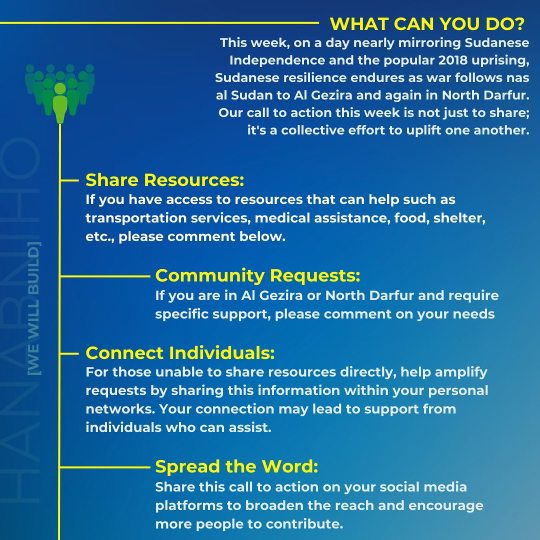
Transcript:
What can you do?
This week, on a day nearly mirroring Sudanese Independence and the popular 2018 uprising, Sudanese resilience endures as war follows nas al Sudan to Al Gezira and again in North Darfur. Our call to action this week is not just to share; it's a collective effort to uplift one another.
Share Resources:
If you have access to resources that can help such as transportation services, medical assistance, food, shelter, etc., please comment below.
Community Requests:
If you are in Al Gezira or North Darfur and require specific support, please comment on your needs
Connect Individuals:
For those unable to share resources directly, help amplify requests by sharing this information within your personal networks. Your connection may lead to support from individuals who can assist.
Spread the Word:
Share this call to action on your social media platforms to broaden the reach and encourage more people to contribute.
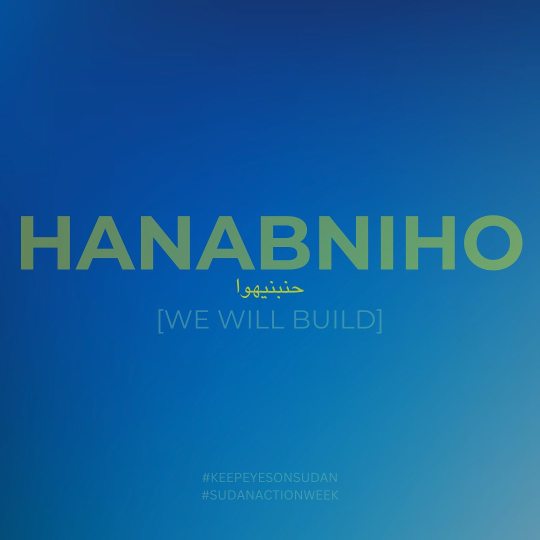
Transcript:
Hanabniho
حنبنيهوا
[We will rebuild]
#keepEyesOnSudan
#SudanActionWeek
924 notes
·
View notes
Text
Spoilers Ahead for Cookie Run Kingdom!!
(All images below belong to and are credited to Devsisters, the developers of Cookie Run Kingdom.)
So I’ve been reading through all of the transcripts from the official leaks shown in the Carnival of Shadows and I think that it gave us an interesting little look into Silent Salt Cookie (and others but I really wanna focus on Silent Salt for a moment—) and what to expect from their update! I’ve gotta tell you guys, I’m thrilled to bits!
As we saw from their concept art, The Beast Cookies we know now were once supposed to be bug themed (very Hollow Knight core, but I digress—)! This was sorta kept in mind for a couple of them moving forward, for example Mystic Flour’s ‘cocooning’ (since her beta design was based off of an empty silk cocoon). Now, I have a pet theory for how this could potentially affect Silent Salt’s portrayal and how their Soul Jam might affect the cookies around them.
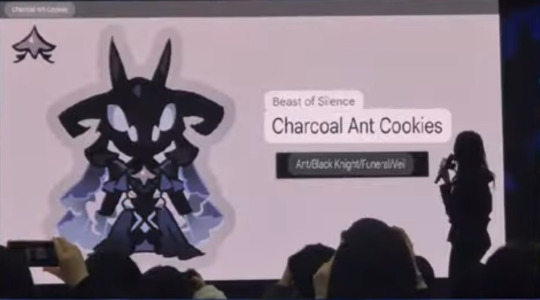
Looking into Silent Salt Cookie’s beta design we can see that they are based on an ant and their followers an ant colony. I think this ties in very well with what Silent Salt used to represent, Solidarity (Solidarity being defined as “Collective unity or agreement among individuals” and what is more unified than a literal colony! I think it’s very clever on Devsister’s part to think about going this direction~!)

Taking a look at what stayed and what went when Devsisters finalized their design, I think we could make some pretty good educated guesses on how they are going to be characterized in their episode.
In the translation it states that their original inspiration was a mix between a “Black Knight” and a “Funeral Veil”, something we can see clearly influencing both designs very heavily (and wonderfully might I add).
In specifics, a ‘Black Knight’ is a character archetype used within literature to describe a figure (usually a villain) who hides their intentions and identity behind their armor. This is done intentionally as to not reveal any of their motivates to their enemies. (They also take note to hide whom they serve.)
Where the ‘Black Knight’ is more of an archetype, the ‘Funeral Veil’ is definitely meant to be more symbolic. More specifically, used to symbolize the act of veiling one’s emotions of deep grief.
With those definitions in mind, I am willing to make the assumption that Silent Salt Cookie is going to be a silent griever. Someone who regrets the past and cannot let go of their pain, perhaps they had kept a secret for years, a terrible and dreadful memory that caused not only their downfall but also, their friends downfall.

(Sound familiar? Eh? Eh? Parallels anyone?!)
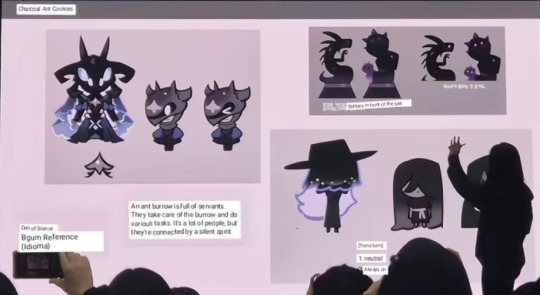
But moving on, reading the translation further it is revealed to say the following “An ant burrow is full of servants. They take care of the burrow and do various tasks. It’s a lot of people, but they are connected by a silent spirit.” This one line was the catalyst to this entire post, and I truly think this line of text reveals so much characterization and context for Silent Salt’s powers it’s unbelievable.
I am going to make the inference (based on the lines above) that Silent Salt Cookie will possess some form of telepathic implantation and hypnotic sway over their followers, and will control them much in the same way a queen ant would her colony (but with less pheromones and more mind control~!) and will be terrifying~!
Each person under their control will still be alive in a sense, but they will no longer be an individual. They will become part of a hivemind, servants tending to the will of the silent spirit that guides their very thoughts and feelings. They would all be silent, for they have no thoughts of their own to share anymore. No differing opinions, no fighting, no fear, it’s the textbook definition of complete and total Solidarity…
Except it can’t be…this ‘Solidarity’ lacks its sister, Freedom. So it can only be described as one thing…Silence.
Anyways, that’s all. Thanks for listening to my rambling. I shall now take my leave! Until next time!
(Bows and exits through a closet.)

(Also, this image is awesome. And you needed to see it!)
#cookie run kingdom#cookie run#cr kingdom#beast cookies#silent salt cookie#character design#character analysis#rambles#beta beast cookie designs#ramblings#writing#analysis
104 notes
·
View notes
Text
The mythology behind Count Orlok and his origins.

In light of recent events, such as the premier of the movie Nosferatu by Robert Eggers, starring Lily-Rose Depp, Bill Skarsgård, and Nicholas Hoult, which in my opinion is an absolute masterpiece that managed to hypnotize me, and bring back from a deep slumber my passions and interests, I decided to go back to my roots and seek the meanings behind Orlok's origins.
Before you reluctantly begin reading or say "did you watch the original movie? do you even know what you're talking about?", remember this is an interpretation of origins, mythology, and perhaps symbolism, since this is what I specialize in.
I did not watch the original Nosferatu, or any other remake or interpretation. Still, I am Romanian, with access to certain information. Although I carry a deep respect for Vlad the Impaler, I will try as much as possible to not bring any similarities between him, Orlok, and of course, Stoker's Dracula, since this is not a comparison article, nor do I have the interest of writing about Vlad or Dracula.
This is mainly about Orlok, Romanian folklore, mythology, and Dacian origins.
The name "Nosferatu" has a vague story behind it as it is not an original name, but a re-writing of the word "necuratul", which in Romanian, is a euphemism for the devil, but could also derive from "nesuferitul" [tr: the insufferable one; the offensive one] or "nefârtatul" [tr: the demon, the devil, the unfriendly, the enemy].
The triggering factor that made me begin my digging was what the old nun from the monastery said while nursing Thomas after being found almost dead by the side of the river.
"aista o fost vrajitor la vremea lui, solomonar" || "he was a sorcerer back in his time, solomonar"
Now, the translation was a bit off, because wizard or sorcerer would be wrong, the most fitting version is in fact "warlock", Orlok being an interpretation or transcription of it.
The definition of warlock is simple - a male practitioner of witchcraft; a man who is thought to be in league with the powers of darkness and to have supernatural knowledge and means of bewitching and harming others; a man who practices black magic.
But what backs up and enriches the mythology behind Orlok is that he was called solomonar, the term being used by Professor von Franz as well.
In Romanian folklore, a solomonar was a sorcerer who was believed to control the clouds and rain, those who could bring hail/storm and heal diseases; they are also known as Zgrimințieș in Țara Moților [Germ: Motzenland], also known as Țara de Piatră [The Stone Land], an ethnographical region of Romania in the Apuseni Mountains, on the upper basin of the Arieș and Crișul Alb River rivers.
Mythology says that the solomonari have a specific book, which contains all their knowledge and power. They study and learn from it in the school from the Babariului Fortress on the Garaleu Mountain [in Dacian times, now somewhere near the Ialomița cave upper from Sinaia, and Babele, the area on the Bucegi Mountains plateau], and not all of them are selected to become a solomonar, only one out of seven. One source states that a solomonar is an initiated priest. This is directly related to the myths about geto-dacian priests called Kapnobatai or Ktisai, who used to live in solitary places, forests, or near the mountain rivers.
One more thing worth mentioning regarding the Solomonar education is that it was believed to be held somewhere at the ends of the Earth in a hole or a cave, and that the lectures would be taught by the devil himself. But not all children would be selected to carry on with such education, only the ones carrying a specific birthmark - a particular type of membrane on their head or on the whole of their body. An extension of this information has it that these students would avoid the sun for seven days during their study, making them some type of Strigoi or Vampire.
Another aspect that has to be written down is the concept of strigoi, as it is directly related to solomonari, having Dacian origins as well.
In Romanian folklore, there are two types of strigoi, the born ones, or the ones who became, and Orlok is most probably one that was turned into a strigoi, as it can be directly linked to the tradition showed practiced by the gypsies, explaining his disgust and slight anger in the scene when Thomas mentioned it.
Those who are believed to become strigoi are children who died without being baptized, the dead who during their life have done terrible things to everyone around them, and those who die young via hanging, drowning, being shot, etc [Vlad the Impaler's older brother is believed to be one as he had an absolutely horrible death, at the age of 17 being beaten, tortured, having his eyes gouged out with hot iron and buried alive], and the dead ones left unsupervised over which a car, dog, mouse, or any other bird has stepped over. Our tradition is to never leave the dead alone in the house until burial and to always be there someone to look over them, especially at night.
My take on Orlok's life before Ellen is that he was indeed a rich man, who practiced black magic, and was feared. Perhaps the villagers hunted him down, killed him, and buried him. That might be how he was turned into a strigoi, which is directly related to the myth of the vampire. But what's more intriguing is that he mentions Ellen waking him up from his slumber, which makes me believe the villagers have experienced some terrors, causing them to dig up his grave and put a spike through his heart, their attempt failing, and having Orlok roaming back on the surface of the Earth again.
#Nosferatu#Count Orlok#Orlok#Nosferatu 2024#Robert Eggers#Lily-Rose Depp#William Defoe#Bill Skarsgård#Nicholas Hoult#Emma Corrin#Aaron Taylor Johnson#mythology#symbolism#folklore#Dracula#romanian
105 notes
·
View notes
Text
MIT Sloan Sports Analytics Conference 2025 - Decisions on Ice: The Next Frontier of Hockey Analytics (YouTube video. Please be advised you WILL be hearing it entirely from your left ear.)
Arda Ocal is moderating, hear from: Philippe Desaulniers (Habs, makes the tools GMs use to fetch data, reports, anything), Meghan Chayka (Stathletes), and Jeremy Rogalski (Bruins - he does get asked about trade deadlines briefly due to the banger that they had this season LOL)
I liked the diversity of voices here, felt like I was getting an interesting cross-section of the kinds of people who work in analytics & their perspectives. Lots of fun things but the first section was what I found most interesting. They talked about how analytics has changed coaching rooms, players and their relationship to analytics, and give a bit of insight on how that interface all goes nowadays. Transcript of that part below <3
ROGALSKI: Echoing what Phil and Meghan said, like, just the way to describe the game. Y'know, working with a - I started in the coach's room doing video work for them, and watching how, even a pre-scout for a game evolves from, y'know, coaches previously would watch like, three games of video and kind of look for some common trends in that, maybe do a deep dive on the season. But now you can describe, like, how a team breaks out, or how their power play formations are in so much detail that wasn't available 10, 15 years ago to put that together.
[...]
ROGALSKI: It's actually interesting you use the word 'storytelling', too, because I think Meghan's bang-on, I think, about a lot of inquiries coming our way now, which is great! But I think also in terms of, y'know, building a relationship with a coach, understanding what their schedule looks like, what their needs are, where they have windows of time to work through and educate on the data.
But also, I think packaging it in a digestible way, right? You're still, in some ways, doing the same thing with a coach where if there's a point you're trying to make, there is a time for a fact: "This guy's whatever on faceoff percentage," that's a fact, that needs to happen. But sometimes you gotta package it in a narrative that really helps them understand how they can then turn around and use that fact to improve the team or communicate to a player. So there is a component of that storytelling that's needed as well.
DESAULNIERS: To tack on what Jeremy was saying... So, I really see three things mainly that are important in order to have communications flowing between our group and the coaches.
The first thing is, really, it's really great to have a translator. You usually will have, like, someone on the team, or you want to have someone on the team who's able to speak the language with the coaches and who understands on the analytics side.
And so we'll be creating some reports, some setting up the information there so it can be consumed, and then you'll have, you, in our (the Montreal Canadiens') case it's Chris our Director of Analytics, who will be talking with the coaches and knowing what the coaches are expecting and presenting it in a way that they understand. So that's one thing.
The second thing that we found effective is, we've started creating some concepts that we try to keep as simple and as high-level as possible, but that then become part of the vocabulary that we have with the coaching staff.
So just to give an example, we'll be talking about players that are, that have a certain number of pillars, we call them pillars, which are at the bottom. They're metrics, very specific metrics, that we're tracking - you don't need to understand all the details to know that, okay, so this guy has a four pillar, or five pillar, and this way you know, like, where he stands at a very high level without having to dig into it.
The third thing that we do, that we've done, is get the coaches on board, so work on a way of organising the metrics based on what they're looking for, what their understanding of the game is, and organise the information that way. So then when they start digging into it they actually see what they were looking for.
And you get the buy-in from them, too, when you're doing that, because they've worked on it to build that structure.
ROGALSKI: I would add one thing, too, that I thought of. You raise a good point, too. I think visuals are huge here, too, right? Whether it's a heat map or just picking the right graphic or trend, or something that's -
DESAULNIERS: Colours!
ROGALSKI: I mean, reds and greens, like, it helps. It truly does help.
CHAYKA: Not to play your role Arda but I have a question for Jeremy, because you've been through some different coaches. Do you find, like, coaching staffs, as they change... From my work I find some are far more, just, ease of use and understanding and their ability to implement it in their game flow. Works a lot better for some people's style than others, have you seen that change with, like, different coaches?
ROGALSKI: Yes. It's definitely seen a change. Also, I think now you're starting to see coaches have worked with different teams, so. Before it's, you're educating on, "This is what we can offer you," now it's, you're coming in with a set of preferences, or, "This is what I worked with previously, " so.
Y'know, more recently it's been coming in with a set of expectations for, "I know this works for me, is there anything you want to add or change or do whatever?" So, it's definitely, there has been a change.
OCAL: That's a great question, I want to generalise that, like, y'know whether it's a first-time coach like Marty St Louis, whether it's a Jim Montgomery, or a long tenured coach... Let me start with you, Meghan, like, from different experience levels of coaches, in the NHL or otherwise, how have you found their acceptance and how they use that in their daily jobs?
CHAYKA: And I think it can be background, too. You know, you, you're a math grad, you like numbers. Some people come from engineering. People come to coaching in so many different ways, so they have such a different way of approach and understanding and ease with it.
And I think that they can just implement it and know what's assumptions and what's noise and what's actually important to them and their job that they need to do. So I think it's just being realistic about your personnel.
But I will say that I've noticed, doing the Draft a lot, and at ESPN and working with Draft people in the CHL and doing a lot of Junior work, that young people now expect data. They want it, they want to take control of their own, whether it's a coach or a player coming up. So I'm seeing, like, the 25-and-under crowd.
It's not, "Do I, should I use analytics?" it's like, "Why aren't we using analytics? Why isn't my agent doing that for me? Why isn't my team doing that for me?"
And I think that, too, both empowers people working in tech but also empowers, like, the person who that data is being used to dictate their career, right? Giving them some control and oversight and insight into what they actually have to improve. So it's kind of, like, flipping it on the head a little bit.
OCAL: The paradigm is changing!
CHAYKA: Correct.
31 notes
·
View notes
Text
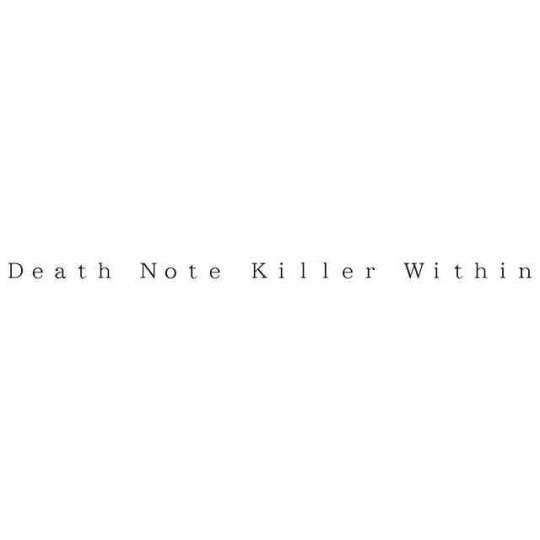
Had a little nose about Death Note Killer Within, my theory through a quick machine translation of this page with details on the trademark application makes me think it might be a videogame, but anyone who knows Japanese may be able to confirm more of the details, please feel free to add to this post

Transcript of the image below:
Release date 2024-06-20
Publication type Trademark Publication
Application number 2024063247
Application date 2024-06-12
Classification: Category 9 (Mechanical Equipment), Category 41 (Education/Entertainment)
90 notes
·
View notes
Text
The Importance of Multilingual eLearning Modules
Bridging Language Barriers in Global Health Education: The Importance of Multilingual eLearning Modules Global health education is essential for addressing public health challenges worldwide. With advancements in educational technology, eLearning is a powerful tool. It helps disseminate health knowledge across different regions. However, language barriers significantly challenge reaching diverse…
#accessibility tools for online education#multilingual transcription services#transcription services#translation services
0 notes
Text
[ENG SUB] Bojan Cvjetićanin for 'Heroji furajo v pižamah' (2021)
In 2021 Bojan took part in the campaign 'Heroji furajo v pižamah' ('Heroes drive in pajamas') by Zavod vozim ('Institute for Innovative Education'), which works in the field of traffic and alcohol and psychoactive substances (PAS) prevention.
The slogan for the 5th season of the initiative was 'Mladi niso več odgovorni' ('Young people are no longer responsible').
The interview is from 24ur with actress Mila Peršin. The full ad (including Bojan's cut) is here.
Transcript and translation by a member of JokerOutSubs, review by drumbeat, proofread by IG GBoleyn123, subtitles by @vesdagrem
Full video on our YouTube channel!
youtube
#joker out#jokeroutsubs#bojan cvjetićanin#bojan cvjeticanin#jan peteh#nace jordan#kris guštin#kris gustin#jure macek#jure maček#year: 2021#source: zavod vozim#og language: slovenian#jo: bojan solo#type: video
40 notes
·
View notes
Text
Transcription under the cut.
Words from Elena Cecchettin, Giulia Cecchettin's sister. Giulia was killed by her boyfriend Filippo Turetta some days ago, at 22 years old. Filippo has been described as exercising control and emotional manipulation during his relationship with Giulia. In the end, he killed her by stabbing her 20 times, and threw her body to the bottom of a ravine. There is video evidence that he killed her.
According to data from Italy’s Interior Ministry, since the beginning of this year 2023, there have been 105 women murdered, and at least 52 of these women were killed by a romantic partner or ex-partner. However, despite the constant femicides, Italian law does not recognise the category of "femicide" as separate from any other kind of murder, because it does not recognising that this disproportionate amount of women murdered for gender-based reasons are, in fact, murders as a result of sexist culture and gender-based violence. That is, a hate crime.
(Transphobes not welcome in this post, 💜🏳️⚧️)
Transcription of the video. Clip from an Italian TV programme where a reporter is holding up a microphone to a young girl. The English translation is this:
I want to send a message and I hope it can be heard by as many people as possible. These days we have heard Turetta be talked about and many people have defined him as a monster, as a sick man. But he's not a monster. Because a monster is the exception to society. A monster is he who is out of our society's normal canons. But he's a healthy son of the patriarchal society which is full of rape culture. Rape culture is all those actions that search to limit women's freedom, such as controlling a phone, like being possessive, like catcalling, and it's a structure that benefits all men. "Not all men are bad", they often tell me. Yes, it's true, but in cases like this, it's always men, and anyway all men benefit from this type of society. So, all men must pay attention, must call out the friend who catcalls passerbys, must call out the workmate that checks his girlfriend's phone. You must be hostile to these behaviours that might look trivial but are the prelude to femicide. Femicide is not a passion crime. Femicide is a power crime. And femicide is a state homicide, because the state doesn't protect us. It's necessary to plan sexual and affective education in order to prevent these things. It's necessary to fund shelters for victims of violence so that, if people need to ask for help, they're able to do it. And for Giulia, I ask you, don't do a minute of silence. For Giulia, burn it all down.
150 notes
·
View notes
Text
I want to rant for a moment. Which if you're following me, I hope you are used to this lol.
This is for the people using comprehensible input to learn Chinese:
Pinyin IS NOT ENGLISH. IT IS NOT ENGLISH TRANSCRIPTION. IT HAS IT'S OWN PRONUNCIATION AND DOES NOT MATCH ENGLISH LETTERS PRONUNCIATION. (Chinese is not pronounced like English, the sounds in pinyin do not match English sounds any more than French letters/pronounciation match the sounds of English - which if you don't know, NO French is not pronounced like English). This is a pronunciation guide for how pinyin sounds and is pronounced.
Pinyin is used in Chinese elementary schools. Pinyin is learned by native speakers, and used to type on phones and computers. Or Zhuyin is learned in elementary schools in Taiwan, and used to type on phones and computers. This is a zhuyin pronunciation guide for how zhuyin sounds and is pronounced.
If you are trying to do a pure Automatic Language Growth approach to studying, pinyin is just a transcription system used for Chinese! It is okay to start reading pinyin whenever you start reading hanzi. It is NOT English translation, or English 'estimation' of pronunciation. (Not any more than the French alphabet or German alphabet is 'English' - and be so for real, I know you know German alphabet isn't pronounced like English so stop pretending Chinese pinyin is pronounced like English). Native speakers see pinyin when they're in school. In some educational materials for native speakers, you'll run into pinyin! You don't need to avoid pinyin once you have gotten to the point in ALG where you're okay with yourself reading hanzi! Once you have acquired enough language to start reading, pinyin and zhuyin are just as 'normal' for native speakers learning to read as hanzi is. You will ultimately NEED to learn pinyin or zhuyin to type.
I am not saying to read Everything with pinyin above the hanzi, once you start reading. By all means skip the pinyin as soon as you are able when reading things. Hanzi is what books are written in, and websites, and you'll need to develop the skill to read hanzi ASAP. You'll want to LOOK at pinyin when learning new words/hanzi, as you'll need to learn how to type it and what sounds match up to the pinyin, or zhuyin, writing system. So learning material like Lazy Chinese's videos that include pinyin? Useful for teaching you how the pinyin matches to sounds, and how to type the new hanzi she teaches you in each lesson.
Pinyin is just an estimate of pronunciation, just like spelling in any language (English spelling is not a perfect guide for how to pronounce English words, French spelling is not a perfect guide for how to pronounce French words, and Chinese pinyin is not a perfect guide for how to pronounce Chinese, like Japanese hiragana is just an estimation - it doesn't capture some sounds in spoken Japanese). You should listen to how actual people are pronouncing words over what pinyin says (for example, some people will say pinyin 'ng' as 'n', or 'shi' as 'si', or 'r' as 'l'). You'll still need to learn pinyin/zhuyin to type and write things digitally.
This post is because I see so many people studying Chinese through comprehensible input, thinking they need to desperately avoid pinyin. I'm sick of it. Pinyin or zhuyin are going to be NECESSARY at some point if you want to know how to type anything!
And unlike English, and French, Chinese language IS very phonetically similar to pinyin's estimates of pronunciation. (For example in English letter 'a' is not ONLY pronounced like 'cat' sometimes it's like 'ate', versus Chinese initials and finals which are quite consistent 'shi' is generally always pronounced the same as any other 'shi' if we're talking Standard Mandarin and not regional accents). If you can learn pinyin or zhuyin, you can type so many words just by hearing them! It took some practice to hear Chinese sounds correctly (obviously) but I can type most every word I have learned in Chinese in pinyin and then select the hanzi I want, just because I've heard the words. I sure couldn't fucking say that about English or French, the way words sound in English or French might not match the spelling much at all.
I'm just... really sick of the misunderstanding that pinyin is a tool for language learners, and no native speakers use pinyin. Native speakers use pinyin or zhuyin, if they're young enough to be using phones and computers. Some native speaker children use pinyin for a little while.
Native speakers also use hanzi to read in all media, and to write on paper, so learn hanzi obviously. You'll need hanzi. Don't try to avoid hanzi.
Hanzi are often phonetic, so knowing pinyin 'qing' for some hanzi with 青 in it, will help you realize how to read, look up, and type: 情 晴 清 蜻 请 青 箐 請 鯖 . Now again, like English, don't assume pronunciation is exactly like the Chinese pinyin, listen to the actual words pronounced. But it sure is a nice regular spelling for typing to pick up and learn.
As someone who learned to read, I do think it's fine and good to move right to reading hanzi directly, or hanzi while listening to matching audio, as soon as possible. You'll need to develop the skill of reading hanzi. Pinyin spelling is fairly regular, and once you get the sense of pinyin's spelling/pronunciation, you'll be able to type most hanzi in pinyin just by hearing the word's pronunciation. You can skip textbooks made for foreigners that use only pinyin for tons of pages (or whole volumes - I hate these textbooks). You can get textbooks that include hanzi from day one (probably with pinyin or zhuyin provided for brand new hanzi so you can sound out the hanzi if you don't have provided audio).
My point is: Don't avoid pinyin just because you're trying to 'learn Chinese in only Chinese.'
I mean, unless you want, in which case sure fuck yourself over and come back in 5 years and let us know how not being able to text or find anything online is going. I'm all for people doing whatever they want. It's your life. Maybe it will go so well, and you'll be able to come back and insist to learners everywhere and native speakers to stop learning pinyin as one learns to read hanzi. Maybe you'll have some awesome benefit to show us, that is acquired by avoiding pinyin. Maybe you come up with a new writing system that's more accurate and easier to write, like the Korean hangul writing system, and it replaces pinyin, zhuyin, and hanzi worldwide.
#rant#pinyin#chinese#chinese learning#studyblr#langblr#chinese pronunciation#zhuyin#I'm being sarcastic with my last paragraph#I mean I do genuinely think you should do what you want - its your decision to make#I just think avoiding pinyin because you stupidly think it's 'english' is equivalent to you shooting yourself in the knee#PLEASE if you're a learner AT LEAST consider learning pinyin or zhuyin.#native speakers learn pinyin or zhuyin if they're young enough to use the internet and digital stuff.#but hey if you want to be a technophobe who never uses the internet and only reads paper books and only writes on paper? sure you probably#don't strictly 'need' to use pinyin or zhuyin ever.
17 notes
·
View notes
Note
you majored in straight up math??? God that's so fuckin cool of you!!
yeah! i've always loved math, so even though i registered late for uni, i knew it would be for math--i just wasn't sure what to do with it. ended up in math-ed. but, unlike some places, i did a double degree, so i have my full mathematics degree & my full education degree
the math degree was so cool. i've really considered going back for my masters since i loved it so much. there's something about pure math that just,,, makes sense to me. proofs are sometimes a pain in the ass, but there's really nothing like staring at one for hours and then it suddenly Clicks and you're off to the races. it's all built on logic--everything that happens makes sense and has a flow.
i also really enjoy the language aspect of it--which a lot of people find couter-intuitive. math should be numbers! but when you do high level math, there's not a lot of numbers involved usually 😂 it's all logic and arguments and specific wording and sentence structure. i love that shit. there's a specific and intentional way to communicate. there's words you use for getting from one idea to the next.
there's a really great video that breaks down how math and language is connected and, in particular, if you're good at 'traditional' math, you might not want a math degree.
here's a transcript:
if you want to go to school for mathematics and this is what you think it'll look like [gestures to background full of equations, trigonometry, and formulas] i suggest you do something else. the joke in the math community is that after sophmore year, you don't see a number over like, 10 again. this is because you learn math as a language. it's like the difference between studying Spanish and studying linguistics. you can study Spanish, but that doesn't mean you'll understand language as a whole. while linguistics studies syntax and semantics because it's the structure of language as a whole that they study. so in this example, if you want to just study spanish, be an engineer. if you decide to take this [math] route, you have two options: pure or applied mathematics. so applied wants to study linguistics as a whole, so they can become a Spanish translator--and maybe pick up Portuguese along the way. while pure mathematics wants to study linguistics so they can make up their own language. it sounds strange but the best mathematicians are often very good with languages too. if you're interested in learning why they have so much in common, then mathematics is for you.
[end ID]
it's like problem solving to the nth degree. a silly example is something like 'what's 1 + 1?' hopefully you know the answer is 2. but in pure math, they'll ask you why 1+1 is 2. and it takes you down this path of laying the foundations for the building blocks of traditional math. (now, that's advanced linear algebra which, frankly, i really disliked, but it's an easy example)
calculus & number theory were actually my 2 favourite 'subjects' in the mathematics we did (which, is very funny bc calculus has the least proofs and you take 4 years of it, vs 1 entirely proofs based course). i was lucky to have really great profs for most of my courses as well
#thank you for calling it cool!!#i mean this in the most heartfelt way: im a fucking nerd#i love learning i love math#you can show me something once and i understand it#genuinely could talk for hours about it#my camera roll is full of proofs i had to write for homework. stuff so obscure you cant find it online. it's just you against the whiteboard#loved it so much#c.text#math#answered
20 notes
·
View notes
Text
Notes on Lord of the Flies (1954 transcription)
by E. L. Epstein, postscript in the 1954 printing of the novel.
[personal note - this is far and away the best analysis of the story I've seen, and seeing that the book was in the process of falling apart, I decided to transcribe it here]
In answer to a publicity questionnaire from the American publishers of Lord of the Flies, William Golding (born Cornwall, 1911) declared that he was brought up to be a scientist, and revolted; after two years of Oxford he changed his educational emphasis from science to English literature, and became devoted to Anglo-Saxon. After publishing a volume of poetry he "wasted the next four years," an when World War II broke out he joined the royal Navy. for the next five years he was involved in naval matters except for a few months in New York and six months with Lord Cherwell in a "research establishment." He finished his naval career as a lieutenant in command of a rocket ship [a 200-ft landing craft modified to carry ~1000 small rockets fired before other landing craft dropped off troops]; he had seen action against battleships, submarines and aircraft, and had participated in the Walcheren and D-Day operations. After the war he began teaching and writing. Today, his novels include Lord of the Flies (Coward-McCann), The Inheritors (which may loosely be described as a novel of prehistory but is, like all Golding's work, much more), and Pincher Martin (Capricorn 66; pub. in hardcover by Harcourt Brace as The Two Deaths of Christopher Martin). He lists his Hobbies as thinking, classical Greek, sailing and archaeology, and his Literary Influences as Euripides and the anonymous Anglo-Saxon author of The Battle of Maldon.
The theme of Lord of the Flies is described by Golding as follows (in the same publicity questionnaire): "The theme is an attempt to trace the defects of society back to the defects of human nature. The moral is that the shape of a society must depend on the ethical nature of the individual and not on any political system however apparently logical or respectable. The whole book is symbolic in nature except the rescue in the end where adult life appears, dignified and capable, but in reality enmeshed in the same evil as the symbolic life of the children on the island. The officer, having interrupted a man-hunt, prepares to take the children off the island in a cruiser which will presently be hunting its enemy in the same implacable way. and who will rescue the adult and his cruiser?"
This is, of course, merely a casual summing-up on Mr. Golding's part of his extremely complex and beautifully woven symbolic web which becomes apparent as we follow through the book, but it does indicate that Lord of the Flies is not, to say the least, a simple adventure story of boys on a desert island. In fact, the implications of the story go far beyond the degeneration of a few children. What is unique about the work of Golding is the way he has combined and synthesized all of the characteristically twentieth-century methods of analysis of the human being and human society and used this unified knowledge to comment on a "test situation". In this book, as in few others at the present time, are findings of psychoanalysts of all schools, anthropologists, social psychologists and philosophical historians mobilized into an attack upon the central problem of modern thought: the nature of the human personality and the reflection of personality on society.
Another feature of Golding's work is the suburb use of symbolism, a symbolism that "works." The central symbol itself, the "lord of the flies," is. like any true symbol, much more than the sum of its parts; but some elements of it may be isolated. The "lord of the flies" is a translation of the Hebrew Ba'alzelvuv (Beelzebub in Greek). It has been suggested that it was a mistranslation of a mistransliterated word which gave us this pungent and suggestive name for the Devil, a devil whose name suggests that he is devoted to decay, destruction, demoralization, hysteria and panic and who therefore fits in very well with Golding's theme.
The Devil is not present in any traditional religious sense; Golding's Beelzebub is the modern equivalent, the anarchic, amoral, driving force that Freudians call the Id, whose only function seems to be to insure the survival of the host in which it is embedded or embodied, which function it performs with tremendous and single-minded tenacity. Although it is possible to find other names for this force, the modern picture of the personality, whether drawn by theologians or psychoanalysts, inevitably includes this force or psychic structure as the foundational principle of the Natural Man. The tenets of civilization, the moral and social codes, the Ego, the intelligence itself, form only a veneer over this white-hot power, this uncontrollable force, "the fury and the mire of human veins." Dostoievsky found salvation in this freedom, although he found damnation in it also. Yeats found in it the only source of creative genius ("whatever flames upon the night./Man's own resinous heart has fed."). Conrad was appalled by this "heard of darkness," and existentialists find in the denial of this freedom the source of perversion of all human values. Indeed one could, if one were so minded, go through the entire canon of modern literature, philosophy and psychology and find this great basic drive defined as underlying the most fundamental conclusions of modern thought.
The emergence of this concealed, basic wildness is the theme of the book; the struggle between Ralph, the representative of civilization with his parliaments and his brain trust (Piggy, the intellectual whose shattering spectacles mark the progressive decay of rational influence as the story progresses), and Jack, in whom the spark of wildness burns hotter and closer to the surface than in Ralph and who is the leader of the forces of anarchy on the island, is also, of course, thru struggle in modern society between those same forces translated onto a worldwide scale.
The turning point in the struggle between Ralph and Jack is the killing of the sow, (pp. 121-131). The sow is a mother: "sunk in deep maternal bliss lay the largest of the lot.. the great bladder of her belly was fringes with a row of piglets that slept or burrowed and squeaked." the killing of the sow is accomplished in terms of sexual intercourse.
They were just behind her when she staggered into an open space where bright flowers grew and butterflies danced round each other and the air was hot and still. Here, struck down by the heat, the sow fell and the hunters hurled themselves at her. This dreadful eruption from an unknown world made her frantic; she squealed and bucked and the air was full of sweat and noise and blood and terror. Roger ran round the heap, prodding with his spear whenever pigflesh appeared. Jack was on top of the sow, stabbing downward with his knife. Roger [a natural sadist who becomes the "official" torturer and executioner for the tribe] found a lodgement for his point and began to push till he was leaning with his whole weight. The spear moved forward inch by inch, and the terrified squealing became a high-pitched scream. Then Jack found the throat and the hot blood spouted over his hands. the sow collapsed under them and they were heavy and fulfilled upon her. The butterflies still danced, preoccupied in the center of the clearing.
The pig's head is cut off; a stick is sharpened at both ends and "jammed in a crack" in the earth. (the death planned for Ralph at the end of the book involves a stick sharpened at both ends.) The pig's head is impaled on the stick; "...the head hung there, a little blood dribbling down the stick. Instinctively the boys drew back too; and the forest was very still. They listened, and the loudest noise was the buzzing of flies over the spilled guts." Jack offers this grotesque trophy to "the Beast," the terrible animal that the littler children had been dreaming of, and which seems to be lurking on the island wherever they were not looking. The entire incident forms a horrid parody of an Oedipal wedding night; these emotions, the sensations aroused by murder and death, and the overpowering and unaccustomed emotions of sexual love experienced by the half-grown boys, plus their own irrational fears and blind terrors, release the forces of death and the devil on the island.
After this occurs the most deeply symbolic incident in the book, the "interview" of Simon, an embryo mystic, with the head. The head seems to be saying, to Simon's heightened perceptions, that "everything was a bad business... the half-shut eyes were dim with the infinite cynicism of adult life." Simon fights with all his feeble power against the message of the head, against the "ancient, inescapable recognition," the recognition of human capacities for evil and the superficial nature of human moral systems. It is the knowledge of the end of innocence, for which Ralph is to weep at the close of the book. "'Fancy thinking the Beast was something you could hunt and kill!' said the head. For a moment or two the forest and all the other dimly appreciated places echoed with the parody of laughter. 'You knew, didn't you? I'm part of you? Close, close, close! I'm the reason why it's no go? Why things are what they are?'"
At the end of this fantastic scene Simon imagines he is looking into a vast mouth. "There was blackness within, a blackness that spread... Simeon was inside the mouth. He fell down and lost consciousness." This mouth,* the symbol of ravenous, unreasoning and eternally insatiable nature, appears again in Pincher Martin, in which the development of the theme of a Nature inimical to the conscious personality of man is developed in a stunning fashion. In Lord of the Flied, however, only the outline of a philosophy is sketched, and the boys of the island are figures in a parable or fable which like all great parables or fables reveals to the reader an intimate, disquieting connection between the innocent, time-passing, story-telling aspect of its surface and the great, "dimly appreciated" depths of its interior.
*cf. Conrad's "Heart of Darkness": "I saw [the dying Kurtz] open his mouth wide--it gave him a weirdly voracious aspect, as though he wanted to swallow all the air, all the earth, all the men before him/" Indeed Golding seems very close to Conrad, both in basic principles and in artistic method.
ISBN: 399-50148-7
8 notes
·
View notes
Text
I don't actually understand the proposed mechanism by which non-phonetic reading is supposed to correspond to lack of understanding? Many people I know (not just my online argument thunderdome Tumblr mutuals) recently have been raising concerns of "people aren't gaining meaning from the text they're reading" and attributing that to "people aren't reading phonetically because of The New Education Programs", without ever really explaining why non-phonetic reading is inferior and causing this lack of understanding.
---
Personal anecdote warning:
I'm biased here, I don't read phonetically, that's never been the default way I read. There is no voice in my head that reads the words aloud when I'm reading, I just look at the words and know what they say. Or I don't know what they say, and then I reread or use context clues and etymology or stop to look a word up. I don't think that diminishes my ability to understand text? I still have the meanings in my head, just not the sounds. But I don't know, because I've only ever been myself.
I can read phonetically, I can sound a word I don't know out, I can read a text out loud if you ask me, but IME it doesn't usually help me understand it any better. Why would you need to know what a text sounds like to understand it? If you're recognising all the words and gleaning the meaning, then you're reading, right? I mean, I can get somebody who's used to primarily engaging with words through speech needing to "translate" between written and spoken language. But I don't do that, in fact often I can feel the inverse, where I feel like I have to "translate" spoken words into thoughts before I can understand them.
For background: I didn't first learn to read in school (for context, I'm nineteen, but went to Montessori school as a child and had fairly non-standard curriculum, I don't remember ever being explicitly taught phonics but that was largely because the teaching was very individualised and I already knew how to read). I learned to read at two or three by teaching myself. In part by memorising books my parents read to me before bed, in part by, you know, picture books that teach children how to read, you put the picture and the word and now I know what the word means. In no part here did I need to know what the word sounded like, so that was just never part of the reading process for me.
End personal anecdote
---
This isn't, like, an attempt at an argument, I'm not making a case here, I'm just genuinely asking, because it's entirely possible I am literally just living in Plato's reading cave here.
Are people just used to phonetic reading themselves, only capable of parsing words as speech, and the written word as a transcription of speech, and thus think non-phonetic reading is non-reading? Or what? Am I just a special little boy? I don't think I'm a special little boy. But I don't understand. Why would you need the sounds. They're words with meaning. Am I autistic*? Are you autistic? Are we all autistic?
*Editor's note: I am, in fact, autistic
5 notes
·
View notes